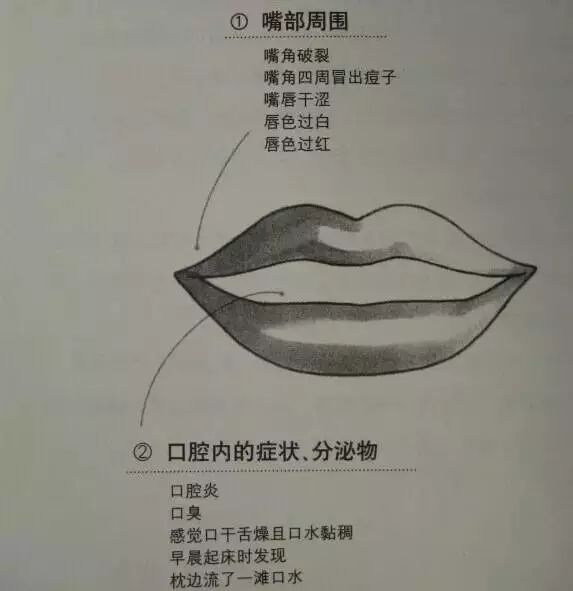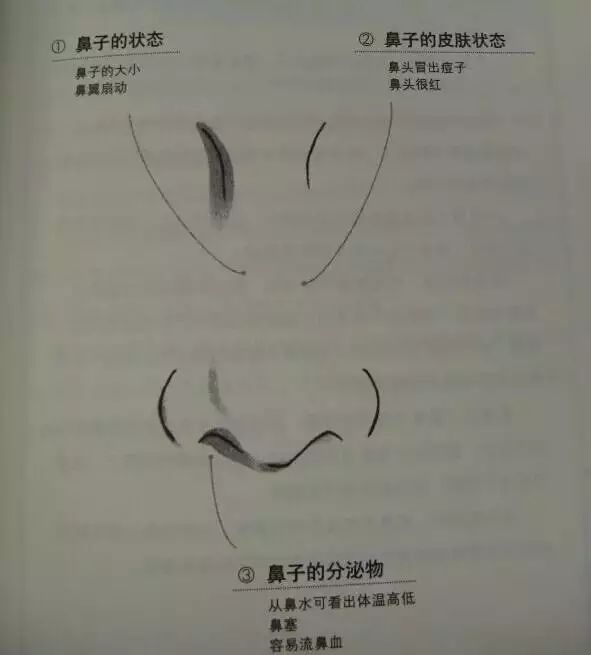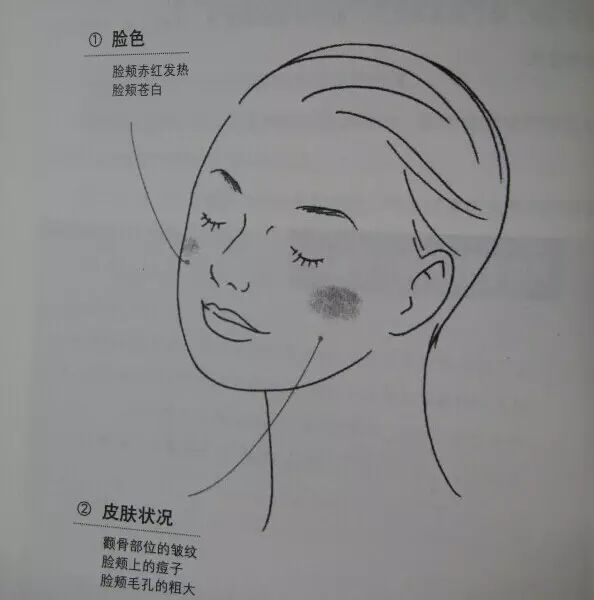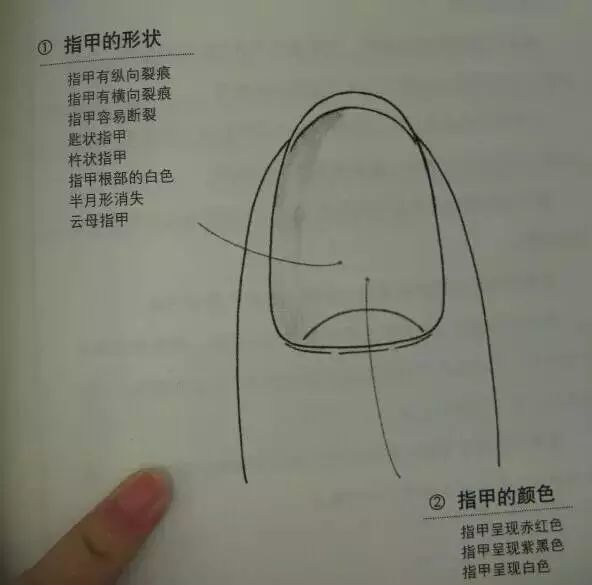 Eyes1. Symptoms around the eyesSwollen eyelids — Indicates reduced function of internal organs (kidneys, gastrointestinal, heart) leading to fluid retention in the body.Dark circles — Occur when blood contains excessive old waste, causing the area around the eyes to appear dull (kidneys).Wrinkles below the eyes — One of the signs of aging.Sunken eye sockets — Indicates excessive consumption of body energy.White inner eyelids — A symptom of anemia.Yellowish-white small bumps on eyelids — Indicates high cholesterol.2. Eye conditionsYellowing of the sclera — A warning sign of liver and gallbladder issues (jaundice).Blood vessels in the sclera — Indicates excessive tension in the liver, causing blood vessels to become engorged.Eye twitching — A warning sign of declining immunity.3. Functional disorders of the eyesInability to fully close eyes during sleep — Caused by poor gastrointestinal function leading to overall muscle weakness.Easy eye fatigue — Indicates liver function deficiency.4. Eye secretions“Eye discharge” — Yellow eye discharge indicates “pus” (inflammation).Dry eyes — Can easily lead to eye diseases.Excessive tearing — Occurs when liver function is weakened.Mouth
Eyes1. Symptoms around the eyesSwollen eyelids — Indicates reduced function of internal organs (kidneys, gastrointestinal, heart) leading to fluid retention in the body.Dark circles — Occur when blood contains excessive old waste, causing the area around the eyes to appear dull (kidneys).Wrinkles below the eyes — One of the signs of aging.Sunken eye sockets — Indicates excessive consumption of body energy.White inner eyelids — A symptom of anemia.Yellowish-white small bumps on eyelids — Indicates high cholesterol.2. Eye conditionsYellowing of the sclera — A warning sign of liver and gallbladder issues (jaundice).Blood vessels in the sclera — Indicates excessive tension in the liver, causing blood vessels to become engorged.Eye twitching — A warning sign of declining immunity.3. Functional disorders of the eyesInability to fully close eyes during sleep — Caused by poor gastrointestinal function leading to overall muscle weakness.Easy eye fatigue — Indicates liver function deficiency.4. Eye secretions“Eye discharge” — Yellow eye discharge indicates “pus” (inflammation).Dry eyes — Can easily lead to eye diseases.Excessive tearing — Occurs when liver function is weakened.Mouth 1. Symptoms around the mouthCracked corners of the mouth — Caused by gastritis leading to false appetite.Acne around the corners of the mouth — Indicates weak gastrointestinal function.Dry lips — Increased body temperature can cause dry lips.Pale lips — A warning sign of insufficient blood.Red lips — Indicates excessive heat accumulation in the body.2. Oral symptoms and secretionsStomatitis — Evidence of reduced immunity.Bad breath — Can have five causes (active gastritis, indigestion, rhinitis, gum disease, dental plaque).Feeling of dry mouth and thick saliva — Indicates overall body fluid deficiency.Finding a pool of saliva on the pillow in the morning — Indicates weak gastrointestinal function.Tongue
1. Symptoms around the mouthCracked corners of the mouth — Caused by gastritis leading to false appetite.Acne around the corners of the mouth — Indicates weak gastrointestinal function.Dry lips — Increased body temperature can cause dry lips.Pale lips — A warning sign of insufficient blood.Red lips — Indicates excessive heat accumulation in the body.2. Oral symptoms and secretionsStomatitis — Evidence of reduced immunity.Bad breath — Can have five causes (active gastritis, indigestion, rhinitis, gum disease, dental plaque).Feeling of dry mouth and thick saliva — Indicates overall body fluid deficiency.Finding a pool of saliva on the pillow in the morning — Indicates weak gastrointestinal function.Tongue 1. Shape of the tongueJagged edges on the tongue — Indicates swelling caused by excessive fluid.Cracked tongue surface — Indicates fluid deficiency.2. Movement of the tongueSlanted tongue — A signal of cerebrovascular disorders.Trembling tongue — Indicates body weakness.3. Color of the tongueRed tongue body — Indicates elevated body temperature.Pale tongue body — Indicates body weakness.Purple tongue — A signal of overly thick blood.Varicose veins on the tongue’s back — A dangerous signal of poor blood flow.4. Size of the tongueLarge and thick tongue — Indicates excessive fluid in the body.Small and thin tongue — Indicates fluid deficiency in the body.5. Thickness of the tongue coatingThick tongue coating, almost obscuring the tongue surface — Indicates gastrointestinal disorders or serious diseases.Thin tongue coating, almost invisible — Indicates body weakness or allergic constitution.6. Color of the tongue coatingWhite tongue coating — Indicates low body temperature and reduced body function.Yellow tongue coating — Indicates internal “heat”.Black tongue coating — Indicates extreme physical exhaustion.Nose
1. Shape of the tongueJagged edges on the tongue — Indicates swelling caused by excessive fluid.Cracked tongue surface — Indicates fluid deficiency.2. Movement of the tongueSlanted tongue — A signal of cerebrovascular disorders.Trembling tongue — Indicates body weakness.3. Color of the tongueRed tongue body — Indicates elevated body temperature.Pale tongue body — Indicates body weakness.Purple tongue — A signal of overly thick blood.Varicose veins on the tongue’s back — A dangerous signal of poor blood flow.4. Size of the tongueLarge and thick tongue — Indicates excessive fluid in the body.Small and thin tongue — Indicates fluid deficiency in the body.5. Thickness of the tongue coatingThick tongue coating, almost obscuring the tongue surface — Indicates gastrointestinal disorders or serious diseases.Thin tongue coating, almost invisible — Indicates body weakness or allergic constitution.6. Color of the tongue coatingWhite tongue coating — Indicates low body temperature and reduced body function.Yellow tongue coating — Indicates internal “heat”.Black tongue coating — Indicates extreme physical exhaustion.Nose 1. Condition of the noseSize of the nose — Indicates strength of respiratory function.Nostrils flaring — Indicates difficulty in breathing.2. Skin condition of the noseAcne on the nose tip — May indicate respiratory issues.Red nose tip — A signal of excessive alcohol consumption.3. Nasal secretionsNasal discharge can indicate body temperature — Treatment for colds varies based on the type of nasal discharge.Nasal congestion — If ignored, can lead to systemic hypoxia.Frequent nosebleeds — Often caused by weak gastrointestinal function.Cheeks
1. Condition of the noseSize of the nose — Indicates strength of respiratory function.Nostrils flaring — Indicates difficulty in breathing.2. Skin condition of the noseAcne on the nose tip — May indicate respiratory issues.Red nose tip — A signal of excessive alcohol consumption.3. Nasal secretionsNasal discharge can indicate body temperature — Treatment for colds varies based on the type of nasal discharge.Nasal congestion — If ignored, can lead to systemic hypoxia.Frequent nosebleeds — Often caused by weak gastrointestinal function.Cheeks 1. ComplexionRed and hot cheeks — Indicates abnormal temperature regulation.Pale cheeks — Indicates insufficient oxygen supply in the body.2. Skin conditionWrinkles on the cheekbones — Mainly caused by ultraviolet rays.Acne on the cheeks — Pay attention to diet excess or constipation.Enlarged pores on the cheeks — Reduced sebum is the main cause of enlarged pores.Teeth1. Condition of the teethProne to cavities — A precursor to osteoporosis.Gray teeth — Indicates cavities forming inside the teeth.2. Condition of the gumsSwollen gums — Indicates gastritis or fatigue.Gums prone to bleeding — Indicates gum inflammation or weak gastrointestinal function.Hair
1. ComplexionRed and hot cheeks — Indicates abnormal temperature regulation.Pale cheeks — Indicates insufficient oxygen supply in the body.2. Skin conditionWrinkles on the cheekbones — Mainly caused by ultraviolet rays.Acne on the cheeks — Pay attention to diet excess or constipation.Enlarged pores on the cheeks — Reduced sebum is the main cause of enlarged pores.Teeth1. Condition of the teethProne to cavities — A precursor to osteoporosis.Gray teeth — Indicates cavities forming inside the teeth.2. Condition of the gumsSwollen gums — Indicates gastritis or fatigue.Gums prone to bleeding — Indicates gum inflammation or weak gastrointestinal function.Hair 1. Hair qualityThinning hair — Indicates a tendency towards anemia or aging.Adolescent baldness — Excessive fat intake can deplete hair (reproductive organ decline).Excessive hair loss — Can indicate early signs of disease.Premature graying — Related to calcium levels and hair.Curly hair — Indicates thinning hair quality.Excessive split ends and breakage — Menstruation can cause hair anemia.2. Condition of the scalpExcessive dandruff — Divided into “dry” (iron and protein supplementation) and “oily” (improving lipid metabolism, supplementing Vitamin B) types.Soft and lack of elasticity scalp — Indicates symptoms of swelling.Nails
1. Hair qualityThinning hair — Indicates a tendency towards anemia or aging.Adolescent baldness — Excessive fat intake can deplete hair (reproductive organ decline).Excessive hair loss — Can indicate early signs of disease.Premature graying — Related to calcium levels and hair.Curly hair — Indicates thinning hair quality.Excessive split ends and breakage — Menstruation can cause hair anemia.2. Condition of the scalpExcessive dandruff — Divided into “dry” (iron and protein supplementation) and “oily” (improving lipid metabolism, supplementing Vitamin B) types.Soft and lack of elasticity scalp — Indicates symptoms of swelling.Nails 1. Shape of the nailsVertical ridges on the nails — Indicate “wrinkles” formed by aging.Horizontal ridges on the nails — Indicate records of “past” (body discomfort).Nails prone to breakage — Indicates anemia or poor liver function.Spoon nails — A distress signal from the body (severe anemia, uterine fibroids, endometriosis; detailed examination recommended).Clubbing nails (feeling of pressure deformity) — Common in individuals with heart disease.Disappearance of the white crescent at the nail base — Indicates physical decline.Dry nails — Indicate a dry state of the nails.2. Color of the nailsRed nails — Indicates overly thick blood (pay attention to cardiovascular health).Purple-black nails — Indicates unclear blood or poor heart function.White nails — Indicates a tendency towards anemia.Source: Combined medications, online resources
1. Shape of the nailsVertical ridges on the nails — Indicate “wrinkles” formed by aging.Horizontal ridges on the nails — Indicate records of “past” (body discomfort).Nails prone to breakage — Indicates anemia or poor liver function.Spoon nails — A distress signal from the body (severe anemia, uterine fibroids, endometriosis; detailed examination recommended).Clubbing nails (feeling of pressure deformity) — Common in individuals with heart disease.Disappearance of the white crescent at the nail base — Indicates physical decline.Dry nails — Indicate a dry state of the nails.2. Color of the nailsRed nails — Indicates overly thick blood (pay attention to cardiovascular health).Purple-black nails — Indicates unclear blood or poor heart function.White nails — Indicates a tendency towards anemia.Source: Combined medications, online resources
 Long press the QR code to recognize and follow
Long press the QR code to recognize and follow

